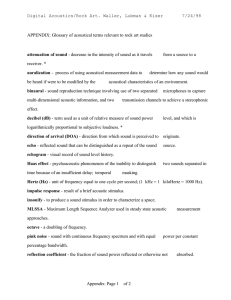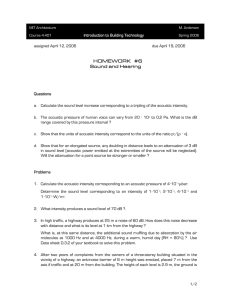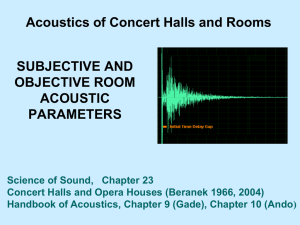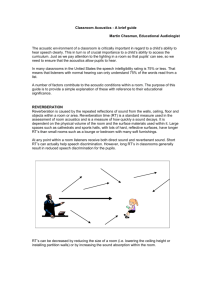EBook `Acoustics in Educational Buildings`
advertisement
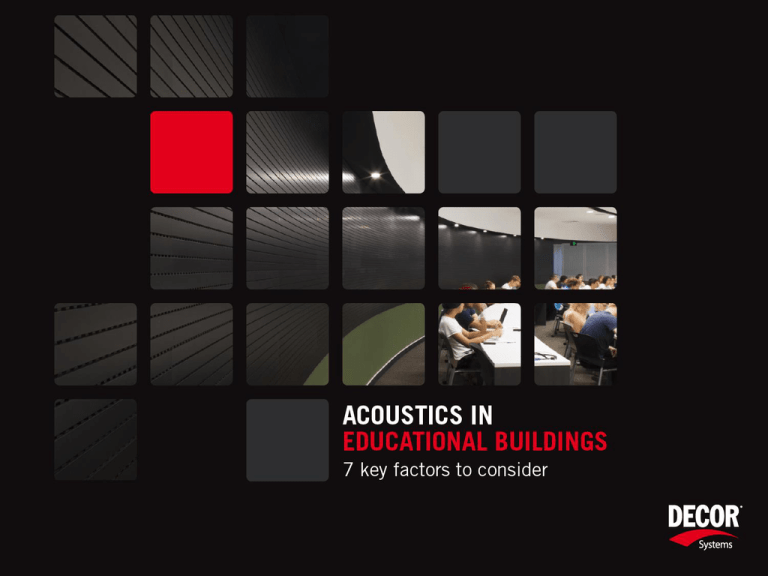
Contents THINK ACOUSTICS FIRST – NOT LAST 3 WHO BENEFITS FROM IMPROVED ACOUSTICS? 4 CONSIDER KEY LEARNING ENVIRONMENT CRITERIA Background Noise Reverberation Signal-to-Noise Ratio 5 6 7 8 HOW TO CONSIDER FOR HEARING IMPAIRED STUDENTS 9 CONSIDER THE TEACHER 10 SUBJECT SPECIFIC LEARNING AREAS Music Rooms Lecture Halls and Auditoriums Libraries Gymnasiums 12 13 14 16 17 ACOUSTICS GLOSSARY 18 THINK ACOUSTICS FIRST – NOT LAST Classroom acoustics are an important, often neglected, aspect of the learning environment. Up to 60% of classroom activities involve speech between teachers and students or between students, indicating the importance of environments that support clear communication. However, classrooms that have been constructed in the last 20 to 30 years to better engage students in hands-on activities or discussions have often resulted in active, noisy environments. Additionally, HVAC systems have created distracting background noise in classrooms. Inappropriate levels of background noise, reverberation, and signal-to noise ratios can also inhibit reading and spelling ability, behaviour, attention, concentration, and academic performance. Furthermore, children who develop language skills in poor acoustic environments may develop long-term speech comprehension problems. Good classroom acoustics are a basic classroom need, not an accessory, to give all students access to spoken instruction and discussion. Acoustic problems persist in classrooms because of a lack of acoustics education for architects and engineers, the prohibitive expenses of acoustic refurbishment, and because adult listeners often do not consider the limitations of children’s hearing abilities. 3 WHO BENEFITS FROM IMPROVED ACOUSTICS? Put simply, the answer is both students and teachers. Children, especially those younger than 13 years of age, have an undeveloped sense of hearing, making the impacts of background noise on hearing, comprehending, and learning more pronounced for children than adults. Students with learning, attention, or reading deficits are more adversely affected by poor acoustic conditions than the average student. Students speaking English as a second language (ESL) require significantly better acoustic conditions to hear the teacher than others. Hearing-impaired students require a significantly better acoustic environment to adequately hear than the average student. Loud or reverberant classrooms may cause teachers to raise their voices, leading to increased teacher stress and fatigue. 4 CONSIDER KEY LEARNING ENVIRONMENT CRITERIA Acoustical barriers to learning may exist even if teachers and/or students are unaware that they exist. Adults’ perceptions of speech intelligibility are often better than children’s perceptions, indicating adults should not rely on their own subjective assessments of listening conditions inside of a classroom. Speech intelligibility decreases when background noise increases or with long reverberation times. When both background noise and long reverberation times are present, they have a combined effect on both people with and without normal speech, hearing, and language. Designers should focus on controlling background noise levels, reverberation times, and signal-to-noise ratios to improve the acoustic environment of schools. 5 BACKGROUND NOISE Excessive noise in schools has a negative impact on student learning and performance While a 1 decibel (dB(A)) change in sound level is barely noticeable, background noises are perceived as doubling in loudness every 10 dB(A). Background noise in unoccupied classrooms should not exceed 30-35 dB(A). Major sources of background noise include: • • • • 6 HVAC noise (vents, ductwork, A/C unit) Outdoor noise (automobiles, airplanes) Reflected speech sounds (echo) Noise from adjacent spaces REVERBERATION Reverberations occur when sound waves strike surfaces (e.g., floors, walls, ceilings) in a room and are reflected back into the space. Reverberation will continue until all the sound waves have been absorbed or have dissipated. Reverberations are affected by the quantity and effectiveness of sound-absorbing surfaces in a room. Sound reflective surfaces are typically hard and smooth. They provide little friction to absorb sound energy, prolonging sound reverberation. Sound-absorbing surfaces are typically fibrous or porous, significantly reducing sound energy through friction between the air and material fibres. Sound-absorbing surfaces can help reduce sound reflection and reverberation, but they do not reduce the intensity of the sound’s source itself. Reverberation times (RT) should not exceed 0.4 seconds in classrooms primarily used by hearing disabled students or 0.6 seconds in general classrooms. Reducing the RT to acceptable limits will help with speech intelligibility, and the added absorption will reduce the overall sound level within the room without adversely affecting the signal-to-noise ratio. 7 SIGNAL-TO-NOISE RATIO Signal-to-noise ratios (SNRs) generally become less favourable for hearing as the distance between the speaker and the student increases, suggesting that different locations within an individual classroom may have different SNRs SNRs are typically lowest at the back of classrooms or near a noise source (e.g., air conditioning unit). Students seated in the rear of a classroom may not understand a teacher’s speech to the same extent as one seated at the front of the classroom. Children with hearing disabilities generally require significantly higher SNRs than children with normal hearing. Environments with SNRs of +20 dB to +30 dB provide optimal speech comprehension for children with hearing disabilities. SNRs should meet or exceed +15 dB in allocations of a classroom. 8 HOW TO CONSIDER FOR HEARING IMPAIRED STUDENTS Hearing-impaired students or students using amplification devices (e.g., cochlear implants, personal FM sound field systems) require lower reverberation times and less background noise than an average student to hear adequately. Typical classrooms do not meet the acoustical needs of hearing-impaired students. The following design recommendations pertain specifically to classrooms occupied by hearing impaired students: Install high performance (0.95 NRC) acoustic tiles in classrooms with hearing-impaired students to reduce classroom reverberation times. Specify easily movable sound-absorptive materials in classrooms with hearing-impaired students so they can relocate to other rooms as the children advance to new classrooms. For cost-effectiveness, ensure materials are easy for school maintenance or custodial staff to install. Reverberation times in classrooms with hearing-impaired students or students using hearing assistive technologies (e.g., cochlear implants) should not exceed 0.4 seconds. Assign support personnel (e.g., speech/language pathologist, teacher’s aide) to assist hearing-impaired students in classrooms. 9 CONSIDER THE TEACHER The acoustical characteristics of unoccupied classrooms may vary significantly from occupied classrooms. Even the sound quality in classrooms designed for excellent acoustics can decline when the classroom is occupied. Working with teachers to anticipate the activities that will take place in the classroom is an important aspect of creating a satisfactory acoustic environment. Following are important points for consideration: • Consider teaching methods and learning styles when planning the classroom’s acoustical environment, as they can have a significant impact on the type of noise created. • Encouraging the following classroom procedures and teaching styles may improve the learning environment: • Observe classroom sessions before undertaking classroom modifications, paying attention to the location of the teacher, student teacher distance, the teaching methodology (e.g., lecture, group discussion), sources of background noise, and student disabilities. 10 CONTINUED… • Understand that the type of noise created in primary classrooms (K-6) may be significantly different than that of secondary classrooms (7-12) • Encourage teachers to speak with clear pronunciation, a reduced tempo, and a slightly higher pitch to more effectively communicate with students. • Educate students, particularly those with poor hearing, about proper listening habits and strategies to improve their hearing ability. • Enhance visual communication in environments with poor acoustics to accommodate students unable to adequately hear the teacher. • Observe classroom sessions before undertaking classroom modifications, paying attention to the location of the teacher, student-teacher distance, the teaching methodology (e.g., lecture, group discussion), sources of background noise, and student disabilities. • It is important to understand that the type of noise created in primary classrooms (K-6) may be significantly different than that of secondary classrooms (7-12). 11 SUBJECT SPECIFIC LEARNING AREAS Different rooms in schools (e.g., study, lecture halls, music halls, nurseries, auditoriums) require different acoustic performance standards based on the room’s purpose. Large rooms (larger than 20 square metres; e.g., auditoriums) require different acoustic design requirements than general classrooms, as they often differ in size, shape, and function. The teacher student configuration within spaces is often fixed; however, the shape of the room can vary greatly. Additionally, HVAC systems often have greater capacities and speech reinforcement systems and other audiovisual aids are typically present in these rooms. The following are design considerations for some of these principal spaces commonly found in schools. 12 MUSIC ROOMS 13 • Provide 2.5 square metres of floor area per person for band rooms and 1.5 square metres per person for chorus rooms to adequately size rooms for ideal acoustic performance. • Ensure ceiling heights are at least 4500 mm high, although even higher ceilings offer better performance. • Separate music rooms from neighbouring quiet spaces (e.g. classrooms, administration offices, libraries) with unoccupied buffer areas. • Include more sound-absorbing surfaces in rooms primarily used for teaching and more sound-diffusing surfaces in rooms primarily used for performance. • Install quiet ventilation systems. • Increase wall sound-isolation levels to prevent music performances from disturbing other classrooms. LECTURE HALLS AND AUDITORIUMS 14 • Distribute reflective and absorbent surfaces evenly across both ceilings and walls of large auditoriums to improve acoustic performance. For spaces with ceilings higher than 3600 mm, consult an acoustic professional to provide sufficient reverberation control. • Use hard, sound-reflecting materials (e.g., plasterboard) over the front and centre of the ceilings of large halls to project speakers’ voices towards the rear of the room. • Provide sound absorption along the edges of the ceiling to control sound reverberation if necessary. Use sound-reflecting material above the lecturer to create sound reflections into the audience in small auditoriums • Use sound-absorbing materials and/or tilt the back wall of small auditoriums to minimize echoes and avoid unwanted reflections. CONTINUED… 15 • Specify upholstered chairs in small auditoriums to ensure less reverberation variability, no matter how many seats are occupied. Pitch seating steeply to support audience lines of sight and hearing. • Reduce background noise levels to below NC-35 and reverberation times to below 1.5 seconds to improve lecture hall speech intelligibility. • Consider using the “variable acoustics” technique (i.e., using movable panels, drapery, and other items that can be rearranged to create different acoustical environments) when designing school auditoriums that have the potential to be used for a variety of purposes. LIBRARIES 16 • Locate libraries away from sources of internal and external noise. • Arrange seating into small groups spread apart to encourage quiet discussion. • Mask distracting noises with steady, non-distracting sounds such as an unobtrusive ventilation system • Install carpet to reduce sound levels. GYMNASIUMS 17 • Hang sound-absorbing baffles or banners from the ceiling to reduce reverberation times. • Include sound-absorbing panels above perforated metal and fibreglass roof decking on ceilings to reduce reverberation times. • Install acoustical panels or bleachers on at least one of two parallel walls to reduce flutter echoes. ACOUSTICS AND AIR QUALITY Using sound-absorbing materials in some classrooms has led to concerns about indoor air quality (IAQ) and multiple chemical sensitivity. However, good acoustical design and IAQ can be achieved when proper materials are specified and maintained over time. Review the following factors to provide satisfactory acoustics and IAQ simultaneously: Consider how material composition, potential off-gassing, and operation and maintenance strategies may affect IAQ when specifying materials for acoustic purposes. Be aware that needs of other building systems (e.g., lighting, thermal, ventilation) may interfere with optimal acoustic designs; however, special architectural elements (e.g., acoustic doors, acoustic windows) are available that decrease the negative effects on acoustics. Consider acoustical ceiling tiles and wall panels in elementary classrooms over soft furnishings and cloth wallhangings to improve the acoustic environment while minimizing fire and health hazards. 18 ACOUSTICS GLOSSARY Absorption Coefficient (alpha) The dimensionless ration of absorbed to incident sound energy from a single interaction between a sound wave and a partition. Values range from 0 to 1. Absorption The product of absorption coefficient and surface area of a material, in units of sabins, used to designate the amount of sound absorbed by that material. The properties of a material composition to convert sound energy into heat thereby reducing the amount of energy that can be reflected. Attenuation The reduction of sound energy as a function of distance traveled. Decibel (dB) A unit of sound level implying 10 multiplied by a logarithmic ration of power or some quantity proportional to power. The logarithm is to the base 10. Sound intensity is described in decibels. For example: breathing, 5 dB; office activity 50 dB; jet aircraft during take-off at 300' distance, 130 dB. Frequency (f) The number of oscillations or cycles per unit of time. Acoustical frequency is usually expressed in units of Hertz (Hz) where one Hz is equal to one cycle per second. Interpreted subjectively as pitch. Humans can hear sounds having frequencies between 20 and 20,000 Hz. 19 Hertz (Hz) Frequency of sound expressed by cycles per second. Noise Reduction Coefficient (NRC) A single number rating system for absorption coefficients over the speech frequency range. The NRC of an acoustical material is the mathematical average to the absorption coefficients at 250, 500, 1000, 2000 Hz. Pitch The perceived auditory sensation of sounds expressed in terms of high or low frequency stimulus of the sound. Sound Absorption Property possessed by materials, objects and air to convert sound energy into heat. Sound waves reflected by a surface cause a loss of energy. That energy not reflected is called an absorption coefficient. Sound Absorption Coefficient (SAC) The fraction of energy striking a material or object that is not reflected. For instance, if a material reflects 70% of the sound energy incident upon its surface, then its Sound Absorption Coefficient is 0.30. SAC = absorption / area in sabins per sq. ft. Wavelength Distance between two identical positions in the cycle or wave. Sound that passes through air produces a wavelike motion of compression and refraction. Length of sound wave varies with frequency. Low frequency equals longer wavelengths. 20
